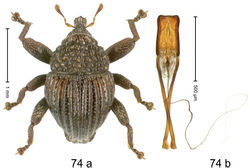Trigonopterus scabrosus
| Notice: | This page is derived from the original publication listed below, whose author(s) should always be credited. Further contributors may edit and improve the content of this page and, consequently, need to be credited as well (see page history). Any assessment of factual correctness requires a careful review of the original article as well as of subsequent contributions.
If you are uncertain whether your planned contribution is correct or not, we suggest that you use the associated discussion page instead of editing the page directly. This page should be cited as follows (rationale):
Citation formats to copy and paste
BibTeX: @article{Riedel2013ZooKeys280, RIS/ Endnote: TY - JOUR Wikipedia/ Citizendium: <ref name="Riedel2013ZooKeys280">{{Citation See also the citation download page at the journal. |
Ordo: Coleoptera
Familia: Curculionidae
Genus: Trigonopterus
Name
Trigonopterus scabrosus Riedel sp. n. – Wikispecies link – ZooBank link – Pensoft Profile
Diagnostic description
Holotype, male (Fig. 74a). Length 2.08 mm. Color of legs and elytral base dark ferruginous; antenna light ferruginous; remainder black. Body subovate, in dorsal aspect and in profile with distinct constriction between pronotum and elytron. Rostrum with median carina bordered by pair of sublateral furrows, posteriorly continued to hind-level of eyes; at level of antennal insertion median carina high, denticulate; with sparse, erect scales; epistome with transverse, angulate ridge provided with three teeth, medially with horn and laterally with pair of teeth. Pronotum with subapical constriction; disk coarsely punctate, areolate. Elytra with striae deeply incised, intervals costate, sparsely setose with minute recumbent setae; interval 7 subapically forming ridge; apex subangulate. Femora edentate. Metafemur with weakly denticulate dorsoposterior edge, in apical third with transverse row of small suberect setae, subapically with stridulatory patch. Abdominal ventrites 1–2 cavernous. Abdominal ventrite 2 projecting dentiform over elytral edge in profile. Aedeagus (Fig. 74b) apically subtruncate; transfer apparatus small, tridentate; ductus ejaculatorius without bulbus. Intraspecific variation. Length 1.90–2.45 mm. Color of elytra ranging from almost black (except base of intervals 4–5 ferruginous) to ferruginous in basal half. Female rostrum dorsally with low median costa bearing two rows of punctures, bordered by pair of lateral furrows, without protrusions; epistome simple.
Material examined
Holotype (MZB): ARC0759 (EMBL # HE615442), WEST NEW GUINEA, Manokwari, Mt. Meja, S00°51.497’, E134°04.949’, 220 m, 05-XII-2007, sifted. Paratypes (ARC, SMNK, ZSM): WEST NEW GUINEA, Manokwari, Mt. Meja: 3 exx, ARC0760 (EMBL # HE615443), ARC0761 (EMBL # HE615444), same data as holotype; 1 ex, 22-23-IX-1990, sifted; 4 exx, 200 m, 30-XII-2004, sifted.
Distribution
Manokwari Reg. (Mt. Meja). Elevation: 200–220 m.
Biology
Sifted from leaf litter in lowland forest.
Etymology
This epithet is based on the Latin adjective scabrosus (rough) and refers to sculpture, especially the one of the pronotum.
Notes
Trigonopterus scabrosus Riedel, sp. n. was coded as “Trigonopterus sp. 204” by Tänzler et al. (2012)[1].
Original Description
- Riedel, A; Sagata, K; Surbakti, S; Rene Tänzler, ; Michael Balke, ; 2013: One hundred and one new species of Trigonopterus weevils from New Guinea ZooKeys, 280: 1-150. doi
Other References
- ↑ Tänzler R, Sagata K, Surbakti S, Balke M, Riedel A (2012) DNA barcoding for community ecology - how to tackle a hyperdiverse, mostly undescribed Melanesian fauna. PLoS ONE 7 (1): e28832. doi: 10.1371/journal.pone.0028832
Images
|
